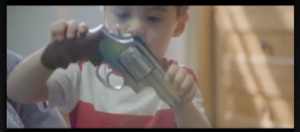SB 1026 : Child Access Prevention
Position: Support Status: Died in House Committee On Judiciary
Creates crime of endangering a minor by allowing access to a firearm. Requires gun dealer to post notice concerning obligation to prevent minors from accessing firearm without consent of minor’s parent or guardian.
Update
3-20-17: Referred to Judiciary, then Ways and Means. 3-15-17: Introduction and first reading. Referred to President's desk. Chief Sponsors: Senator Riley, Representatives Smith Warner, Keny-Guyer Regular Sponsor: Representative Piluso
- SB 1026 holds guns owners responsible if a minor accesses an unsecured gun.
- Just as child car seat laws reduced car crash death and injury in children, child access prevention (CAP) laws can reduce firearm death and injury. (“Results provide evidence that booster seat laws are effective in increasing the use of child safety seats, increasing the placement of children in rear seats, and reducing injuries, especially severe injuries, among children covered by the laws.” Effects of Booster Seat Laws on Injury Risk Among Children in Crashes. AH Eichelberger et al. Traffic Inj Prev 13 (6), 631-639.
- The bill exempts gun owners if a minor obtains the firearm as the result of an unlawful entry into the premises by any person; or the firearm is located in a locked container that a reasonable person would believe is secure from being opened by a minor; or the firearm is locked with a device that: (A) A reasonable person would believe is secure from being unlocked by a minor; (B) Is designed to prevent unauthorized users of the firearm from firing the firearm; and (C) Has rendered the firearm temporarily inoperable.
- A 2013 study indicates that “…CAP laws are associated with reductions in nonfatal gun injuries among children under age 18.” (“Child Access Prevention Laws and Nonfatal Gun Injuries.” Jeffrey DeSimone, Sara Markowitz and Jing Xu
Southern Economic Journal Vol. 80, No. 1 (July 2013), pp. 5-25 Published by: Southern Economic AssociationStable URL: http://www.jstor.org/stable/23809515 Vol. 80, No. 1 (July 2013), pp. 5-25)
- SB 1026 does not mandate that are firearms are secured.
- SB 1026 complies with Oregon’s firearm pre-emption law, ORS 166.170, which states that only the State of Oregon has the right to regulate firearm “sale, acquisition, transfer, ownership, possession, storage, transportation or use of firearms.”
- SB 1026 educates the public about safe storage of firearms and also provides justice to families whose children have been killed or injured by the failure of gun owners to properly secure their firearms.
- Secure storage could include securing the firearm in a proper holster on the gun owner’s person.
- From 2003 to 2012, fifty-two adolescents aged 10 to 17 years used a gun to commit suicide. (Oregon Health Authority, “Suicides in Oregon: Trends and Associated Factors 2003 – 2012,” page 29.)
- That is about 1 young person who uses a gun to commit suicide every 2.5 months in Oregon.
- Suicide among adolescents accounted for approximately two percent of suicides in Oregon from 2003 to 2012.
- During this period, the rate of suicide among adolescents was 3.1 per 100,000; the rate ratio between males (4.3 per 100,000) and females (1.9 per 100,000) was 2.3.
- Firearms and hanging / suffocation were the most common mechanism of death among males (44% respectively), followed by poisoning (7%).
- Among females, hanging / suffocation was the most common mechanism (58%), followed by firearms (34%) and poisoning (8%) (Table 2A).
- Nearly one third of adolescents who died by suicide had disclosed their intent to kill themselves before they died.
